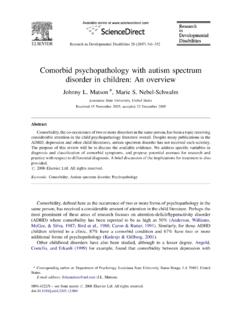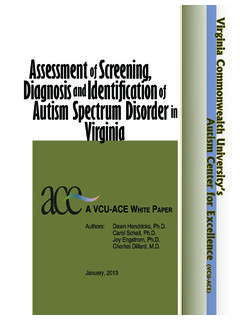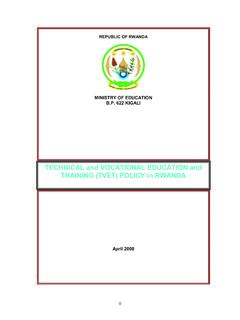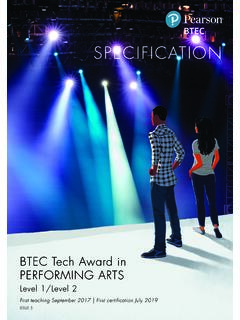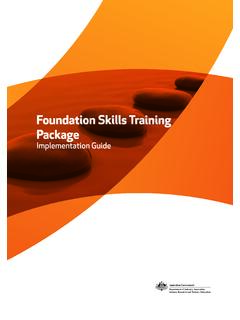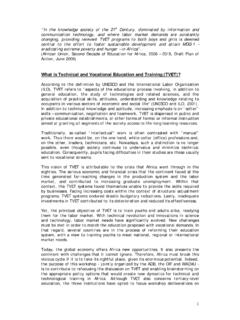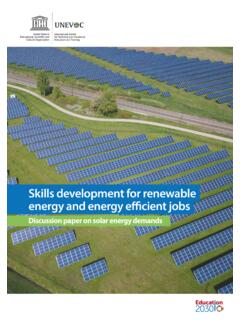Transcription of community based Functional skills assessment for t ...
1 Rehabilitation ReseaRchand tRaining centeRcommunity based Functional skillsassessment for transition aged Youth with Autism spectrum DisorDerJUNE 2014 PAGE Introduction ..1 What is an assessment ? ..1 How does it work? ..3 1. assessment and Observation Planning Tool ..3 2. Scheduling the Observation ..3 3. Conducting the Observations ..3 4. Conducting the Interview ..3 5. Scoring the assessment ..3 6. Calculating the Score ..4 assessment and Observation Planning Tool ..5 A. Client Details ..5 B. People Interviewed ..5 C. Interest and Preferences ..5 D. Education ..6 E. Medical Information ..6 F. Benefit Status ..7 assessment Planning ..7 Functional skills assessment -- OBSERVATION ..9 Home Observation ..9 Self-Determination/Advocacy.
2 9 Health and Safety ..9 Peer Relationships, Socialization, Social Communication ..10 Leisure/Recreation ..11 Home Living ..12 Leisure/Recreation Observation ..15 Self-Determination/Advocacy ..15 Health and Safety ..15 Peer Relationships, Socialization, Social Communication ..16 community Participation and Personal Finance ..18 Leisure/Recreation ..19 Transportation ..20 TABLE OF CONTENTSAUTISM SPEAKS7 PAGE Work Observation ..23 Career Path and Employment ..23 Self-Determination/Advocacy ..24 Health and Safety ..24 Peer Relationships, Socialization, Social community Participation and Personal Finance ..27 Leisure/Recreation ..28 Transportation ..29 Functional skills assessment -- INTERVIEW ..31 Career Path and Employment ..31 Self-Determination/Advocacy ..33 Health and Safety.
3 34 Peer Relationships, Socialization, Social Communication ..37 community Participation and Personal Finance ..40 Transportation ..42 Leisure/Recreation ..43 Home Living ..44 Score Sheet ..47 ABout the assessment This assessment tool was developed for Autism Speaks through a contract with Virginia Commonwealth University s Rehabilitation Research and Training Center. While a review of the literature did not produce an assessment tool that matched the needs of youth with Autism Spectrum Disorder (ASD), it did assist in illuminating the critical areas of Functional life skills . The project selected these Functional skills areas based upon the instruments that were reviewed and purported to contribute to the successful functioning of an individual into adulthood. This tool was designed to assess an individual s knowledge , skill and social communicationabilities. A number of individuals worked on this product to include Carol Schall, Valerie Brooke, Paul Wehman, Sue Palko, Alissa Brooke, Whitney Ham, Staci Carr, Peter Gerhardt, Adam Dreyfus, and Holly Tate.
4 Additional thanks go to Katherine Inge for her review of this document and to the number of individuals with ASD, their families and educators that trusted us with their time and talent as we worked collaboratively to shape this final product. ABout the VirgiNiA commoNweALth uNiVersity rehABiLitAtioN reseArch AND trAiNiNg ceNterEstablished in 1983, the Virginia Commonwealth University Rehabilitation Research and Training Center (VCU-RRTC) serves as a center of national and international excellence in the field of disability and employment services. The VCU-RRTC played a major leadership role in designing and implementing supported employment, a program now found in every state across the country and over 30 countries worldwide. For over 30 years this center has stayed in the forefront of education and employment services to individuals with disabilities with a concentration on services and supports to individuals with autism. The Center s pro-fessional team, led by Dr. Paul Wehman, are renowned experts and committed to developing and advancing evidence based practices to support and advance individuals with disabilities.
5 ABout Autism speAksAutism Speaks is the world s leading autism science and advocacy organization. It is dedi-cated to funding research into the causes, prevention, treatments and a cure for autism; increasing awareness of autism spectrum disorders; and advocating for the needs of individuals with autism and their families. Autism Speaks was founded in February 2005 by Suzanne and Bob Wright, the grandparents of a child with autism. Mr. Wright is the former vice chairman of General Electric and chief executive officer of NBC and NBC Universal. Since its inception, Autism Speaks has committed more than $500 million dollars to its mission, the majority in science and medical research. Each year Walk Now for Autism Speaks events are held in more than 100 cities across North America. On the global front, Autism Speaks has established partnerships in more than 40 countries on five continents to foster international research, services and awareness. To learn more about Autism Speaks, please visit contents were developed for Autism Speaks, Functional community based assessment .
6 Virginia Commonwealth University, School of Education and Department of Physical Medicine and Rehabilitation is an equal opportunity/affirmative action institution providing access to education and employment without regard to age, race, color, national origin, gender, religion, sexual orientation, veteran s status, political affiliation, or disability. If special accommodations are needed, please contact Vicki Brooke at (804) 828-1851 VOICE or (804) 828-2494 TTY. 1 The challenges associated with the transition from school services to adulthood for individuals with disabilities are well documented. The process can often be a very overwhelming and challenging one as families worry about the individual s future: What kind of job will he have? Where will she end up living? Will he ever be independent? What will make her the happiest? Every individual with autism is different and as a result, there is no one size fits all plan for the path to adulthood. A transition plan involving job training and skill development that is fitting for one person with autism may be ineffective for another.
7 The most important factor in creating a plan is to focus on the individual. His or her strengths, needs, challenges and preferences will play a critical role in ensuring a successful transition process. A key ingredient in creating a transition plan for an individual with autism is a transition assessment that leads to comprehensive skill development in the final years of school. When a student turns 14, the focus of his or her Individualized Education Program will likely shift away from math and English to vocational training and community living skill development. This shift in focus necessitates a shift in assessment priorities. That is, instead of measuring what a student cannot do, it is time to measure the student s interests, preferences, strengths and work habits and based on these factors, describe the supports and modifications that will be necessary for the student to be successful in the future. IntroductionWhat is an assessment ?The community based Functional skills assessment for Transition Aged Youth with Autism was designed to help parents and professionals assess the current skill levels and abilities of individuals with autism beginning at age 12 and continuing into adulthood in order to develop a comprehensive plan.
8 The purpose is to assist teams in identifying areas of instructional priority for the individual. While employment support needs of individuals are addressed through community - based internships and work experiences through school, this is the first tool to assess needs in the area of community - based living from transportation to financial management to peer relationships and more. The tool is designed for transition aged youth and is divided into three levels based upon the age of the individual being assessed. This is important because the skills identified will be age-referenced based on the individual s peer group. The levels and definitions are as follows: Level 1 Life Aware: This group includes youth ages 12 to 16 who are between middle school and sophomore year of high school. Level 2 Life Explorer: This group includes youth ages 17 to 22 who are in their junior or senior year of high school. Level 3 Life Seeker: This group includes individuals who are post high school and seeking postsecondary education and/or employment.
9 Rehabilitation ReseaRchand tRaining centeRcommunity based Functional skills assessment for transitionaged Youth with Autism spectrum DisorDer2 After conducting a careful analysis to illuminate the critical areas of Functional life skills , eight skill sets were identified and collapsed into the categories below:CAreer pAth And employment The items in this section assess the individual s progress towards developing job seeking skills and/or employment. This section covers such job topics as: demonstrates work habits by performing chores at home, explores opportunities by job shadowing, volunteer or using a mentor, indicates personal strengths, completes a resume and secures a competitive The items in this section review the skills that youth with autism need to develop and the challenges that they will face living and working in the community . Specifically, this section will cover a variety of skills that would indicate that the individual is able to demonstrate some control of his or her life.
10 This section covers skills such as: goal setting, IEP participation, choice making, self-regulation, problem solving, requesting support and disability awareness. heAlth And SAfety assessment items in this area cover a vast range of independent living skills . These items include basic to advanced hygiene, fire safety, home safety, medication management, self-management and general sexuality information. peer relAtionShipS, SoCiAlizAtion And SoCiAl CommuniCAtion This area is the most detailed section of the assessment . For individuals with ASD, the interaction between two or more people, requiring the processing of both verbal and nonverbal cues, can be an arduous task. It is important to assess skills across multiple environments because many people with ASD understand language so concretely that they may miss the subtle meanings of social information, as well as experience issues with generalization. This section covers skills across home, work and leisure/recreation environments while assessing if the individual can initiate a skill, as well as respond to a social communication pArtiCipAtion And perSonAl finAnCe This area focuses on a variety of independent living skills assessed across areas that include making decisions that affect an individual s life, taking care of personal affairs and pursuing areas of personal interest.
